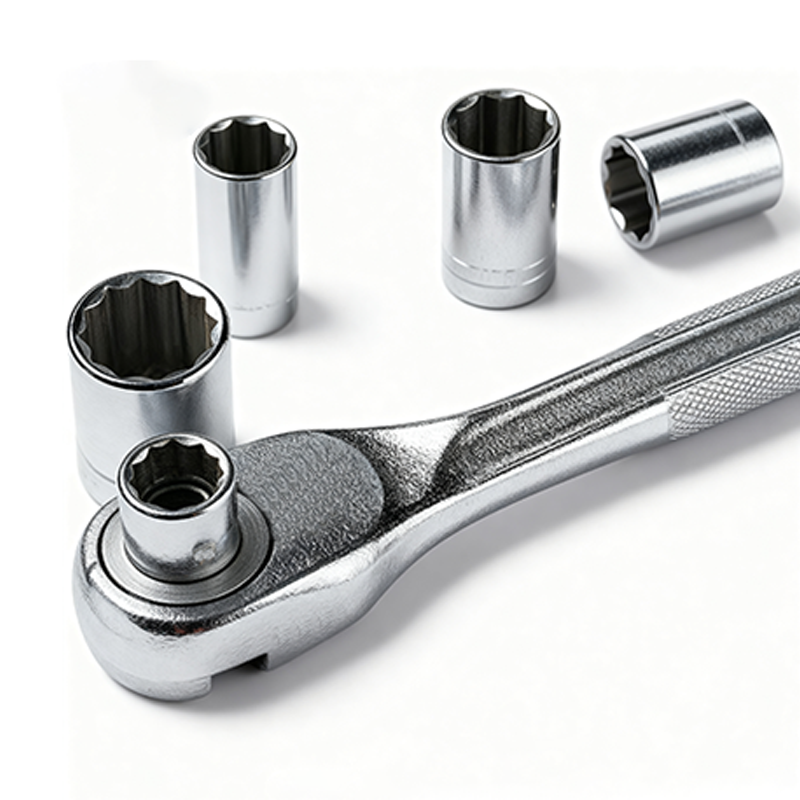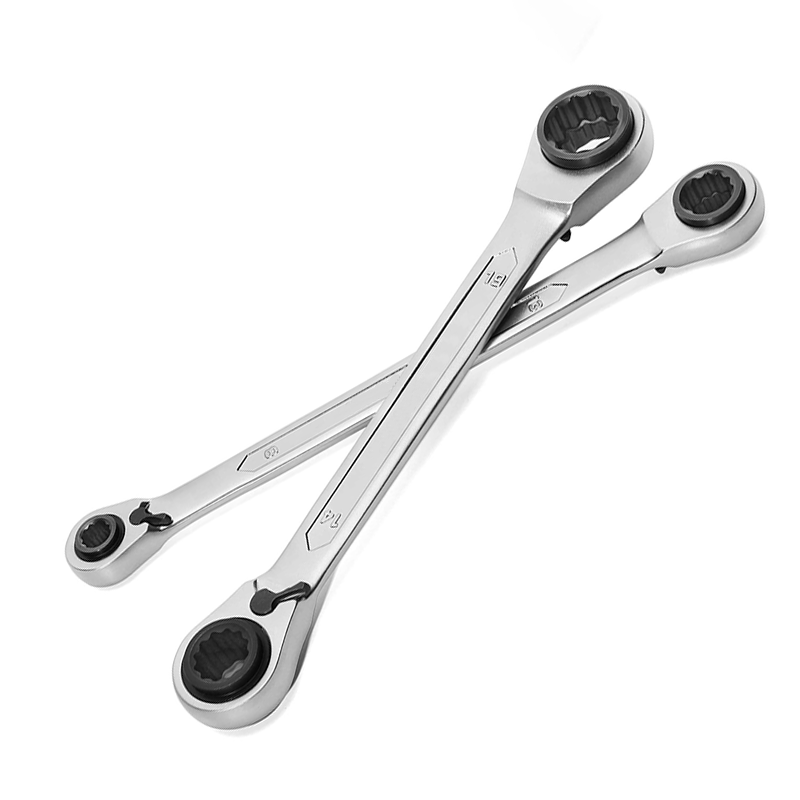For whosoever operateth heavy machinery, a set of fine maintenance instruments is of indispensable necessity. When thou findest thyself confronted with a bolt upon the equipment most obstinate to tighten, the proper implement may resolve such vexation within but five minutes. Within the realm of instruments employed for the twisting of nuts and bolts, the appellations “socket wrench” and “ratchet wrench” are with great frequency interchanged, whereby much bewilderment is occasioned. Are they indeed the same contrivance? If not, which among them dost thou require? This present guide shall dispel thine perplexity, unravel the principal distinctions betwixt the two, and aid thee in discerning which instrument is the rightful choice for the weighty labors thou dost encounter daily.
What Is a Wrench & Socket Wrench?
To unravel the quarrel between the socket wrench and the ratchet wrench, we must first apprehend that these two appellations are often misemployed. They are not two wholly disparate instruments, but rather constituent portions of one and the selfsame contrivance. Let us, then, proceed to assay the matter.

What is a Socket Wrench?
A socket wrench is best delineated as a system composed of manifold constituents, which, in concerted operation, serve the purpose of tightening or loosening fasteners. It is not, in its essence, a solitary implement. The system is constituted of the following portions:
- Socket: This is a detachable head, capable of being affixed to a nut or bolt. The socket manifests in a profusion of dimensions and configurations (for instance, 6-point, 12-point, deep, shallow), such that it may accommodate almost any fastener.
- Handle: This is the instrument that conjoins with the socket and imparts leverage to rotate it. Herein lies the principal distinction, for the handle assumes diverse forms. The two most prevalent are the non-ratchet handle (such as a breaker bar) and the ratchet handle.
In essence, a ratchet is but one species of socket-wrench handle, though not every socket-wrench handle partakes of the ratchet’s nature.

What is a Ratchet Wrench?
The ratchet wrench, or in brief “ratchet,” is a peculiar handle of the socket wrench, within whose internal structure there exists a specialty. Its principal characteristics may be enumerated as follows:
- Ratcheting Mechanism: Inside, the gear and pawl arrangement allows you to swing the handle forth and back, yet the socket itself remains unmoving. In one direction, it utters the sound of “ka-da,” while in the opposite direction, it holds tightly, thus permitting you to rotate the fastener continuously, without the necessity of lifting the tool away from the bolt.
- Reversible Action: Upon the head, there is a diminutive lever or dial, enabling you to change at once the direction of force. Hence, within but one second, you may switch from the state of tightening to that of loosening.
- Speed and Efficiency: The foremost intention of the ratchet mechanism is the saving of both time and labor, particularly when one is engaged in a narrow space or upon bolts with threads of considerable length.
Socket Wrench vs Ratchet Wrench: Key Differences
Now that we’ve clarified that the real comparison is between a ratcheting handle and a non-ratcheting handle (like a breaker bar), let’s explore the critical differences. For an equipment owner, these distinctions directly impact your workflow, the life of your tools, and your safety.
1. The Core Mechanism
- Ratchet Wrench: The heart of the ratchet is its complex internal mechanism. It allows for continuous motion in one direction. This design is all about speed and convenience.
- Socket Wrench: This tool is the definition of simplicity. It is a solid piece of metal with a pivoting head. The square drive that connects to the socket is fixed. There are no small, internal moving parts to break. This design is all about strength and durability.
2. Torque Application and Strength
This is the most important difference for anyone working on heavy machinery.
- Ratchet Wrench: A ratchet is not designed for extreme torque. The internal gears and pawls are the weak point. If you try to apply massive force—such as when trying to break loose a large, rusted bolt on an undercarriage—you can easily strip the gears or break the pawl, destroying the tool. Using a “cheater bar” (a pipe placed over the handle for more leverage) on a ratchet is a guaranteed way to break it.
- Socket Wrench: This tool is built for one main purpose: applying maximum torque. Because it is a solid bar, you can put your full body weight on it or use a cheater bar without risk of breaking an internal mechanism. It is the undisputed champion for breaking loose stubborn, high-torque fasteners.
3. Speed and Efficiency
- Ratchet Wrench: The ratchet is the king of speed. In the tight confines of an engine bay or when removing a bolt with long threads, the ability to turn the fastener without repositioning the tool is a massive time-saver. The higher the “tooth count” of the ratchet’s internal gear, the smaller the arc you need to swing the handle to engage the next tooth, making it even better for tight spaces.
- Socket Wrench: This tool is slow and methodical. For each turn, you have to swing the handle, lift it off, reposition it, and repeat. It is highly inefficient for general assembly or disassembly.
4. Primary Application
Thinking about the job-to-be-done makes the choice clear. A complete set of hand tools will always include both types because they excel at different tasks.
Ratchet Wrench: Ideal for:
- Quickly removing or installing bolts that are already loose.
- Working in tight spaces where you can only move the handle a few degrees.
- General assembly and disassembly of components.
Socket Wrench: Ideal for:
- “Breaking loose” large, rusted, or over-torqued bolts and nuts.
- Performing the final, high-torque tightening of a critical component.
- Any situation where you need to apply maximum, raw power to a fastener. Every heavy-duty wrench set should have one.

Here is a simple table to summarize the differences:
| Feature | Ratchet Wrench | Socket Wrench |
|---|---|---|
| Mechanism | Internal gear and pawl for one-way motion. | Solid, fixed drive with no moving parts. |
| Primary Use | Speed and efficiency in tight spaces. | Applying maximum torque to break loose bolts. |
| Strength | Moderate. It can be damaged by extreme force. | Very High. Designed for maximum leverage. |
| Speed | Very Fast. No need to reposition the tool. | Slow. Requires repositioning after each turn. |
| Best For | Spinning off loose bolts, general assembly. | Breaking loose stubborn bolts, final tightening. |
Which One Should I Choose?
The answer is not a choice between one or the other. The right answer for any serious mechanic or equipment owner is that you need both.
- Start with the Socket Wrench: When you approach a large bolt on a track frame or a suspension component, start with the Socket Wrench. Use its long handle and solid construction to apply the heavy force needed to break the initial tension.
- Switch to the Ratchet: Once the bolt is loose and can be turned by hand, switch to your ratchet. Now you can spin the bolt out quickly and efficiently without wasting time repositioning the handle.
- Finish with a Torque Wrench (If Needed): For critical bolts that require a specific tightness (like engine or hydraulic components), use a dedicated torque wrench to tighten them to the exact manufacturer specification.
Maintenance and Care for Socket and Ratchet Wrenches
You should regard these implements as an investment, for with just a bit of careful tending, they can accompany you for a lifetime.
- Keep Them Clean: Upon the conclusion of toil, one ought to wipe away all traces of grease, grime, or oil stains. Thus shall corrosion be forestalled, and the ratchet’s contrivance shall be spared from entanglement.
- Lubricate the Ratchet: The inner mechanism of the ratchet does require periodic lubrication. Once or twice a year, apply a single drop of light machine oil into the mechanism to preserve smooth operation.
- Store Them Properly: Cast them not heedlessly into a bucket. Rather, ensconce the wrenches and sockets within a toolbox or casket of storage, lest they collide one against another, or moisture cause their iron to rust.
- Use Them Correctly: Of all stratagems of preservation, the foremost is that the tools be used according to their destined purpose. Do not use the ratchet as a hammer, and most especially, do not use it as a socket wrench. This principle shall spare you from needless expense and preserve the implements in their most excellent state.
Equip Your Workshop for Success
To apprehend the essential divergence between the ratchet wrench (for the augmentation of swiftness) and the socket wrench (for the exaltation of might) is the pivotal key to laboring with efficacy and preserving the implements. A kit of instruments, complete and well-maintained, is the most eminent asset for the utmost diminution of idling duration. When there arises the necessity to fabricate or to elevate the coffer of tools, FridayParts, as a supplier of parts with many years of seasoned experience, can bestow, at the most economical price, a vast multitude of high-quality implements and components. Assure that you have the befitting apparatus for any repair, without the compulsion of disbursing the exorbitant fees of the dealers.
